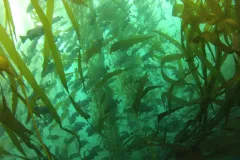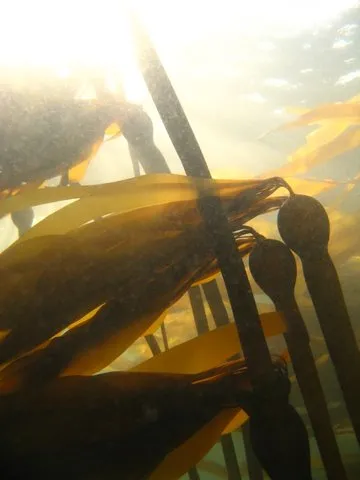Stinkin' Seaweed Makes Tasty Food for Coastal Animals

Most people try to avoid rotting kelp at the beach. The feeling of a floating piece of seaweed wrapping around an ankle is enough to shake even the most steeled swimmer, and then there's the strong smell! But in our research group, we go out of our way to find rotting seaweed at the shore so that we can study how kelp tissues change as they die and decompose.
While this may seem like an odd thing to care about, detached and decomposing kelp blades are actually a very important part of coastal food webs in many cold-water ecosystems. Kelps grow large and fast, but then some perennial species die in the fall (although some kelps are annuals and regerminate every year like some garden plants). Even perennial species get torn from the rock by storms or strong tides, or have their stalks chewed away by sea urchins. This means that there is a lot of kelp that wafts around in local currents and eventually gets washed up on beaches and becomes “stinkin’ seaweed” (or sinks into deep water). All this rotting kelp is a very large potential food source.
The various kinds of living kelps differ in their food quality, especially because some have anti-grazer chemicals that make them bitter and indigestible to animals like urchins. We wondered if rotting kelp—colonized by bacteria that softens its tissue—might be a better food source than live kelp, and if this might depend on the kelp species in question. The changes to rotting kelp might make it a great food source to animals that wouldn’t eat it otherwise.
Over the course of two years, various members of our research group at Friday Harbor Labs (FHL) at the University of Washington worked with six different undergraduates to examine various facets of this question. One student project looked at whether small crustaceans prefer to eat fresh or rotting pieces of two different kelp species; another looked at how the caloric contents of kelps change as they rot; yet another looked at how well populations of copepods multiply when fed fresh or rotting kelp; and more students looked at how well newly-hatched isopods and adult urchins grow on these different diets. When we combined these studies with others from FHL scientists and graduate students, we found that together they told a coherent story about the fate of the kelp we see growing along the shore in the San Juan Islands off of Washington State.
One type of kelp, Agarum, rots very slowly, probably because of its anti-grazer chemicals that also tend to be anti-bacterial. These kelp gradually became better food as they rotted. In contrast, the common bull kelp—a favorite among local kelp-consumers because it has very few of the anti-grazer chemicals—rots much more quickly and generally becomes a less preferred and less valuable food source after it dies. We know little about the particular organisms (bacteria, fungi, etc.) that cause seaweeds to rot, but now we know that this process may be very important in terms of its effects on the food value of all the kelp biomass that washes onto the beach or sinks into deep water.
So next time you turn your nose up at stinkin' seaweed at the beach, take a moment to appreciate that what stinks to you makes a fine meal for many animals that live along the coast.
Reference: Journal of Experimental Marine Biology and Ecology. Vol. 460, p. 72-79 (PDF)


